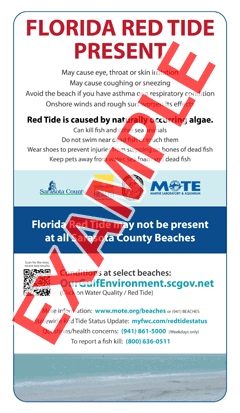It's a New Day in Public Health.
The Florida Department of Health works to protect, promote, and improve the health of all people in Florida through integrated state, county, and community efforts.
Bacteria
Main Administrative Office
- 941-861-2900
- DOHSarasotaInfo@FLHealth.gov
-
Mailing Address
William L. Little Health and Human Services Center
2200 Ringling Blvd
Sarasota FL 34237
Enteric Bacteria
Enteric bacteria water test results
(Note: Results for enterococcus are given in “CFU”, or “colony forming units” and a number of 71 or greater is considered “poor”.)
| Location | Date | Enterococci, CFU/mL | Swim Advisory | |
|---|---|---|---|---|
| Longboat Key | 12/15/2025 | <10 | No | |
| Bird Key Park | 12/15/2025 | 10 | No | |
| North Lido Beach | 12/15/2025 | <10 | No | |
| Lido Beach (Casino) | 12/15/2025 | <10 | No | |
| South Lido Park | 12/15/2025 | <10 | No | |
| Siesta Key | 12/15/2025 | <10 | No | |
| Turtle Beach | 12/15/2025 | 10 | No | |
| Nokomis Beach | 12/15/2025 | <10 | No | |
| North Jetty | 12/15/2025 | 20 | No | |
| Venice Beach | 12/15/2025 | <10 | No | |
| Service Club | 12/15/2025 | <10 | No | |
| Venice Fishing Pier | 12/15/2025 | <10 | No | |
| Brohard Beach | 12/15/2025 | <10 | No | |
| Caspersen Beach | 12/15/2025 | N/A | No | Beach Closed |
| Manasota Beach | 12/15/2025 | <10 | No | |
| Blind Pass | 12/15/2025 | <10 | No |
Table Data Last Modified: Fri Dec 19, 2025 13:34:21 EST
| Good | Moderate | Poor |
|---|---|---|
| 0-35 | 36-70 | 71 or Greater |
Table Data Last Modified: Thu Sep 19, 2024 13:23:37 EDT
Water samples are tested for elevated levels of ‘indicator’ bacteria. These are known as enterococcus or enteric bacteria, some of which are naturally present in the environment. These bacteria are known to inhabit the intestines of humans and warm-blooded animals.
Enteric bacteria can come from a variety of sources, including stormwater runoff, pet waste and wildlife and human sewage from failed septic systems and sewage spills.
Health Risks
When these enteric bacteria are detected in high concentrations in recreational waters, there is a risk of illness and infections. Some people who swallow water while swimming or have contact with water entering the skin through a cut or sore may become ill with gastrointestinal illnesses, infections or rashes.
Vibrio vulnificus
Vibrio vulnificus is another type of bacteria. It is naturally occurring. The Florida Department of Health (DOH) does not sample for this bacteria because it is commonly found in warm, brackish and sea water and in shellfish, especially during the summer months.
DOH is constantly monitoring reportable diseases and has appropriate ways to alert the public if needed.
News reports have incorrectly characterized Vibrio vulnificus as a flesh-eating bacteria. It is important to know that there is no such medical term or marine organism.
Infection by Vibrio vulnificus is a rare but serious disease. It is caused by eating raw or undercooked shellfish, particularly oysters or by exposing cuts and wounds to brackish and salt water where the bacteria exists.
The breakdown of the skin known as necrotizing fasciitis is very rare and is most commonly associated with Group A Strep infections, not Vibrio vulnificus.
Millions of people visit Suncoast beaches each year. If you are healthy, have a strong immune system, and practice good hygiene and proper wound care, your chances of getting necrotizing fasciitis is extremely low.
You can download informational articles provided by DOH about vibrio here:
DOH Fact Sheet[PDF 116KB]
Tips for a Healthy and Fun Day at the Beach[PDF 161KB]
For additional information, please visit the CDC website shown below.
Additional Information about Vibrio vulnificus: Centers for Disease Control and Prevention (CDC): https://www.cdc.gov/vibrio/vibriov.html




Connect with DOH